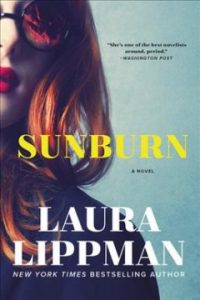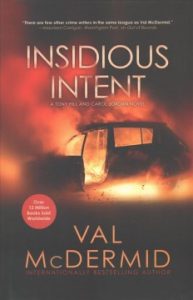…How many thrillers can you count that open with the body of a dead woman? Or thrillers that focus on physical harm or the threat of physical harm being done to a woman? That feature a woman being stalked or threatened? If you stop to think about it, the answer might be surprisingly high.

It’s a little disconcerting to think about how many stories rely on violence against women to drive their plot; whether it’s the discovery of a body, or a report of violence that launches a plot (see, for example, Law & Order: SVU). Or stories that use a character’s history of violence against women to indicate their villainy, or to make them a suspect in a case. Or are driven by the (often violent or deadly) disappearance of a women years in the past?
 It’s even more disconcerting to think about what that means culturally and historically. I discuss with my students regularly about the implications of incidents like, for example, Jack the Ripper…the subject of goodness knows how many books, television series, shows, movies, radio plays, stage production, etc. Some are good, some are great, while others are forgettable and regrettable. But they all hinge on the story of a person (or persons) who murdered women who were economically, socially, and physically incapable of defending themselves. Those women are only known to history because they were murdered in brutal fashion. In some cases, the only reason we know what those women look like is from their autopsy photos. Similarly, in the books we read, we meet so very many women only when, or after, they die. Only after they are labeled as a victim. Only after they have suffered. Only because they have suffered. And how does it affect the way we look at actual, real, flesh-and-blood women who are hurt, victimized, or used in the way that fictional characters are?
It’s even more disconcerting to think about what that means culturally and historically. I discuss with my students regularly about the implications of incidents like, for example, Jack the Ripper…the subject of goodness knows how many books, television series, shows, movies, radio plays, stage production, etc. Some are good, some are great, while others are forgettable and regrettable. But they all hinge on the story of a person (or persons) who murdered women who were economically, socially, and physically incapable of defending themselves. Those women are only known to history because they were murdered in brutal fashion. In some cases, the only reason we know what those women look like is from their autopsy photos. Similarly, in the books we read, we meet so very many women only when, or after, they die. Only after they are labeled as a victim. Only after they have suffered. Only because they have suffered. And how does it affect the way we look at actual, real, flesh-and-blood women who are hurt, victimized, or used in the way that fictional characters are?
And, what do we do about it? Is there anything that can be done about it? Well, last week, writer and educator Bridget Lawless announced The Staunch Book Prize, an award to be presented to “to the author of a novel in the thriller genre in which no woman is beaten, stalked, sexually exploited, raped or murdered.” According to the Staunch Book Prize website, “As violence against women in fiction reaches a ridiculous high, the Staunch Book Prize invites thriller writers to keep us on the edge of our seats without resorting to the same old clichés – particularly female characters who are sexually assaulted (however ‘necessary to the plot’), or done away with (however ingeniously).”

The award is a part of the #MeToo movement, in which women, men, and people around the world are not only sharing stories of their own sexual victimization, but also championing attempts to change the way the world works, and to ensure a more just, inclusive, and safe society for everyone. Within this context, the Staunch Prize argues that making women victims, that hurting women as part of a plot, is a cliche that has gone well and truly stale. As author Andrew Taylor described it in a quote to The Guardian: “It has to be good in principle that someone’s drawing attention to crime fiction, on page and screen, that uses women-as-victims-of-violence as … a sort of literary monosodium glutamate: ie, as a gratuitous and fundamentally nasty flavour enhancer lacking moral or artistic purpose.”
 The announcement of the prize has set off quite a bit of debate, not only among mystery writers, but among activists and readers, as well. Laura Lippman, a multiple-award winner mystery writer, was quoted by NBCNews as saying “My first reaction was, that’s so well-intentioned and probably impossible. Because it’s not the topic of sexualized violence that’s the problem. It’s the treatment…There are literally mysteries in which the cat solves the crime, and then there are these incredibly hard-boiled, how high is the body count, how many prostitutes are you going to murder for the sake of the hero’s development mysteries.”
The announcement of the prize has set off quite a bit of debate, not only among mystery writers, but among activists and readers, as well. Laura Lippman, a multiple-award winner mystery writer, was quoted by NBCNews as saying “My first reaction was, that’s so well-intentioned and probably impossible. Because it’s not the topic of sexualized violence that’s the problem. It’s the treatment…There are literally mysteries in which the cat solves the crime, and then there are these incredibly hard-boiled, how high is the body count, how many prostitutes are you going to murder for the sake of the hero’s development mysteries.”
In other words, how we discuss violence against women is important. Is it possible to use an example of violence against women to comment on, criticize, and actively contest violence against women? As award-winning author Val McDermid noted to The Guardian, “My take on writing about violence against women is that it’s my anger at that very thing that fires much of my work. As long as men commit appalling acts of misogyny and violence against women, I will write about it so that it does not go unnoticed.”
 But some authors feel that this award is a form of censorship, both artistically and socially. Val McDermid was also quoted in The Guardian piece is saying, “To impose a blanket ban on any writing that deals with this seems to me to be self-defeating.” But let’s be clear, hear–the award isn’t punishing books that feature women as “beaten, stalked, sexually exploited, raped or murdered.” Instead, it is awarding books that do not feature these things. The Man Booker Prize isn’t a punishment for books that are not written in English. Nor are the National Book Awards a punishment to books not written by Americans. What it seems to be, most of all, is a challenge: to re-imagine the thriller genre as a place where female characters can exist and develop without victimization. To think about what such a world might look like. Because that seems like a concrete first step to changing the power imbalances in real life–to realize how hard it is to imagine a world without those imbalances.
But some authors feel that this award is a form of censorship, both artistically and socially. Val McDermid was also quoted in The Guardian piece is saying, “To impose a blanket ban on any writing that deals with this seems to me to be self-defeating.” But let’s be clear, hear–the award isn’t punishing books that feature women as “beaten, stalked, sexually exploited, raped or murdered.” Instead, it is awarding books that do not feature these things. The Man Booker Prize isn’t a punishment for books that are not written in English. Nor are the National Book Awards a punishment to books not written by Americans. What it seems to be, most of all, is a challenge: to re-imagine the thriller genre as a place where female characters can exist and develop without victimization. To think about what such a world might look like. Because that seems like a concrete first step to changing the power imbalances in real life–to realize how hard it is to imagine a world without those imbalances.
So what do you think, dear readers? Will the Staunch Book Prize inspire your reader habits?
